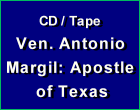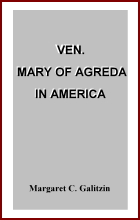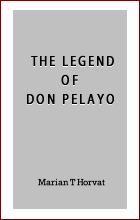American History
 |
 |
 |
 |
 |
 |
 |
Revolutionary Myths against Columbus - I
Rebuttal to the Lies about Columbus
We are at the end of the 16th century. The Habsburgs reign in Spain and from there extended their Catholic Empire over the world. With globe straddling territories and victorious armies Spain was hated by Protestants. Facing defeat on the battlefield, these Protestants turn to the pen to try and defame their hated Catholic enemies.
In the Netherlands printing presses churn spreading tales of Spanish “infamy” with no bother to adhere to reality. That old ill-informed habit of denigrating Spanish accomplishments persists to this day, finding a curiously modern incarnation in the controversy surrounding a non-Spanish figure: the Genovese sailor Christopher Columbus, who was, nonetheless, sponsored in his trips by the Spanish Catholic Monarchs Ferdinand and Isabella.
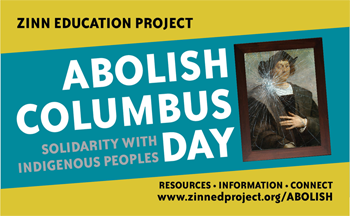 Today, it is becoming increasingly popular to depict Columbus as an archetype of colonial wickedness. He, who once was venerated in schools, is now defamed for a whole host of alleged crimes. Influenced by this defamation campaign, many Americans are replacing Columbus day with “indigenous peoples” day. Often he is blamed by extension for all the atrocities committed by later explorers. Personally, he is depicted as a gold-crazed madman.
Today, it is becoming increasingly popular to depict Columbus as an archetype of colonial wickedness. He, who once was venerated in schools, is now defamed for a whole host of alleged crimes. Influenced by this defamation campaign, many Americans are replacing Columbus day with “indigenous peoples” day. Often he is blamed by extension for all the atrocities committed by later explorers. Personally, he is depicted as a gold-crazed madman.
But, these stories are false. Like the Black Legend of the Inquisition, an investigation into the actual documents of the period reveals a startling different story. Further, these myths are not only perpetuated in our days, but they are actually increasing indicating no regard for intellectual integrity.
From newspapers to blogs the story that Columbus “sailed in 1493 and stole all the he could see” continues to spread with ever more virulent permutations. Like a snowball traveling down the mountain, a single lie gains in size and momentum as other untruths and exaggerations are added to it, until the myth becomes entrenched in the public imagination and people assume it is truth without question. It is a sad testament to the low intellectual level to which our modern times have sunk in respect to truth.
Few researchers could claim Columbus was perfect; he was not, but to unquestioningly subscribe to the myths surrounding him is to buy into a highly ideological lie that holds historical truth subservient to ideological agendas.
Responding to myths
Today, I respond to the following myths slandering the name of Columbus readily found on the internet.
Myth 1: “ Columbus never set foot on America.”
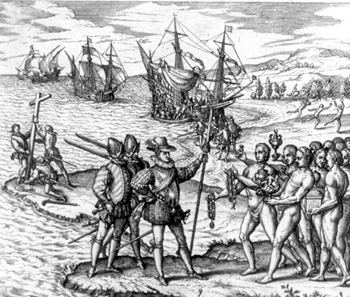 Response: On Columbus’ 3rd and 4th voyages he landed in Central and South Americas. Thus, Columbus can rightly be said to have discovered “the Americas,” regions previously unknown to Europeans. To anyone else but North Americans, the three Americas – South, Central and North – form an ensemble with many points of unity: it was inhabited by Indians and was colonized almost at the same time by Europeans.
Response: On Columbus’ 3rd and 4th voyages he landed in Central and South Americas. Thus, Columbus can rightly be said to have discovered “the Americas,” regions previously unknown to Europeans. To anyone else but North Americans, the three Americas – South, Central and North – form an ensemble with many points of unity: it was inhabited by Indians and was colonized almost at the same time by Europeans.
This general process started with Colombus discovering the Isle of San Salvador in 1492 and it is more than logical that the discovery of one part of the New World should be considered the discovery of the whole.
The difference is that most of Central and South Americas were colonized by Catholics, while North America was initially colonized by Protestants. Hence, it is understandable, therefore, that the Protestants would induced North Americans to believe that they are different and superior to their Central and South American brothers and the only ones who deserve the title of Americans. It is based on this pride and lack of objectivity that this myth took root.
Myth 2: “Columbus brought violence and disease to the Indians.”
Response: The Native Americans were used to warring, committing genocide, enslaving and even practicing cannibalism long before Columbus. The word ‘cannibal’ itself is a derivation of the name for the Carib tribe, the same that give the Caribbean its name. Therefore, it is completely out of reality to attribute all these evils to the Europeans who set foot in the Americas.
Disease was an unintended side effect of Spanish contact, and would have occurred regardless of who traveled between the Europe and the New World. Indeed, it is not difficult to understand that since the Indians had not developed resistance for the habitual diseases Europeans had, when the latter arrived in the Americas their diseases produced devastation among the Aborigines.
Out of context sentences
There are also “quotes” reinforcing other myths by taking single sentences of Columbus’s writings in an attempt to portray him as a monster. From racist to child trafficker, Columbus is accused of a whole host of atrocities relying on “citations” from his journal to prove the point.
 All one must do is look at the original documents written by him and his record keepers to see that these depictions are egregiously false.
All one must do is look at the original documents written by him and his record keepers to see that these depictions are egregiously false.
The book The Northmen, Columbus and Cabot, 985-1503 gives us the texts. Edited by a Yale professor it is translated and freely available in multiple formats here. The following citations are from its 1906 edition.
The following are some of commonly quoted lines to prove Columbus was evil:
Myth 3: Columbus offended the Indians, based on the quote: “Savage cannibals, with dog-like noses that drink the blood of their victims.”
Response: Alleged to be Columbus’s description of natives, in reality this was Columbus’s recording the description given by Taino Indians about the cannibal Carib tribe. Columbus himself dismissed these claims as exaggerations until he and his men came across a village of cannibals and found body parts of men being cooked. (pp. 138, 157, 174, 183, 290)
Myth 4: Columbus despised the Indians, based on the quote: “For with fifty men they can all be subjugated and made to do what is required of them.”
Response: This entry is presented to try and depict Columbus as a power-hungry conquistador evaluating potential Indian victims. In reality this was Columbus relating to the Monarchs how establishing fortresses to protect trade routes did not seem necessary because the islands seemed quite safe. Later experience proved the natives could be quite war-like, but this initial observation is still misquoted to try and paint him as a ruthless conqueror despite his explicitly friendly gestures towards the Indians. (p. 114)
Myth 5:“ [He] sold children into sexual bondage.”
Response: This particular falsehood would be laughable were it not so egregious. The lie has its origin in a letter Columbus sent back to Spain wherein he states:
“There are plenty of dealers who go about looking for girls ; those from nine to ten are now in demand, and for all ages a good price must be paid.”
An appalling indictment. However, citing this quote out of context removes one absolutely vital component of the text: It is explicitly Columbus complaining to the Monarchs of this atrocity. His very next paragraphs states that these traffickers “did not deserve water in the sight of God or the world.”
Far from engaging in such activity, Columbus tried to suppress this behavior on his return to Hispaniola, and begged the Monarchs that more upright men be sent as colonists. Despite this, there are actually those who cite this quote out of context in an attempt to create the narrative that Columbus somehow approved of child exploitation. Anyone who bothers to read the text they are citing can see this through this falsehood. The mendacity of those who persist in spreading this lie is staggering, particularly given how easily the truth is verified. (p. 378)
The real & forgotten Columbus
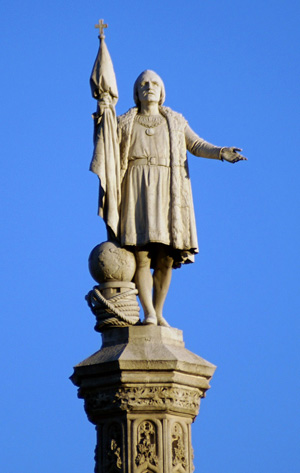 Given the falsehoods spread about Columbus, it is worthwhile to note the behavior that actually characterized this great explorer who is at the center of so much controversy. The 1906 translation of Columbus’ voyages show us the following:
Given the falsehoods spread about Columbus, it is worthwhile to note the behavior that actually characterized this great explorer who is at the center of so much controversy. The 1906 translation of Columbus’ voyages show us the following:
Those who would perpetuate these slanders in the face of such obvious evidence are, at best, guilty of grave ignorance. More realistically, they are culpable of intellectual dishonesty.
Society deserves honest representation of facts rather than ideologically motivated distortions. Those who spread these lies about Columbus are following a revolutionary agenda and build their foundation upon falsehoods. Simply put, if they are willing to lie about such obvious things, what can be believed about anything else they say?
Continued
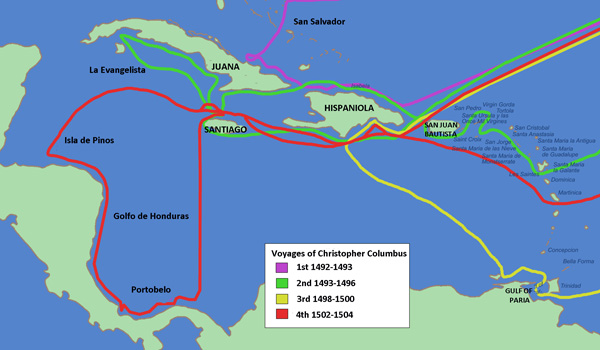

In the Netherlands printing presses churn spreading tales of Spanish “infamy” with no bother to adhere to reality. That old ill-informed habit of denigrating Spanish accomplishments persists to this day, finding a curiously modern incarnation in the controversy surrounding a non-Spanish figure: the Genovese sailor Christopher Columbus, who was, nonetheless, sponsored in his trips by the Spanish Catholic Monarchs Ferdinand and Isabella.

Modern day propaganda is trying to destroy his good reputation
But, these stories are false. Like the Black Legend of the Inquisition, an investigation into the actual documents of the period reveals a startling different story. Further, these myths are not only perpetuated in our days, but they are actually increasing indicating no regard for intellectual integrity.
From newspapers to blogs the story that Columbus “sailed in 1493 and stole all the he could see” continues to spread with ever more virulent permutations. Like a snowball traveling down the mountain, a single lie gains in size and momentum as other untruths and exaggerations are added to it, until the myth becomes entrenched in the public imagination and people assume it is truth without question. It is a sad testament to the low intellectual level to which our modern times have sunk in respect to truth.
Few researchers could claim Columbus was perfect; he was not, but to unquestioningly subscribe to the myths surrounding him is to buy into a highly ideological lie that holds historical truth subservient to ideological agendas.
Responding to myths
Today, I respond to the following myths slandering the name of Columbus readily found on the internet.
Myth 1: “ Columbus never set foot on America.”

Columbus' landing on Hispaniola in America
This general process started with Colombus discovering the Isle of San Salvador in 1492 and it is more than logical that the discovery of one part of the New World should be considered the discovery of the whole.
The difference is that most of Central and South Americas were colonized by Catholics, while North America was initially colonized by Protestants. Hence, it is understandable, therefore, that the Protestants would induced North Americans to believe that they are different and superior to their Central and South American brothers and the only ones who deserve the title of Americans. It is based on this pride and lack of objectivity that this myth took root.
Myth 2: “Columbus brought violence and disease to the Indians.”
Response: The Native Americans were used to warring, committing genocide, enslaving and even practicing cannibalism long before Columbus. The word ‘cannibal’ itself is a derivation of the name for the Carib tribe, the same that give the Caribbean its name. Therefore, it is completely out of reality to attribute all these evils to the Europeans who set foot in the Americas.
Disease was an unintended side effect of Spanish contact, and would have occurred regardless of who traveled between the Europe and the New World. Indeed, it is not difficult to understand that since the Indians had not developed resistance for the habitual diseases Europeans had, when the latter arrived in the Americas their diseases produced devastation among the Aborigines.
Out of context sentences
There are also “quotes” reinforcing other myths by taking single sentences of Columbus’s writings in an attempt to portray him as a monster. From racist to child trafficker, Columbus is accused of a whole host of atrocities relying on “citations” from his journal to prove the point.

A sketch showing the Indians as cannibals, an actual fact
The book The Northmen, Columbus and Cabot, 985-1503 gives us the texts. Edited by a Yale professor it is translated and freely available in multiple formats here. The following citations are from its 1906 edition.
The following are some of commonly quoted lines to prove Columbus was evil:
Myth 3: Columbus offended the Indians, based on the quote: “Savage cannibals, with dog-like noses that drink the blood of their victims.”
Response: Alleged to be Columbus’s description of natives, in reality this was Columbus’s recording the description given by Taino Indians about the cannibal Carib tribe. Columbus himself dismissed these claims as exaggerations until he and his men came across a village of cannibals and found body parts of men being cooked. (pp. 138, 157, 174, 183, 290)
Myth 4: Columbus despised the Indians, based on the quote: “For with fifty men they can all be subjugated and made to do what is required of them.”
Response: This entry is presented to try and depict Columbus as a power-hungry conquistador evaluating potential Indian victims. In reality this was Columbus relating to the Monarchs how establishing fortresses to protect trade routes did not seem necessary because the islands seemed quite safe. Later experience proved the natives could be quite war-like, but this initial observation is still misquoted to try and paint him as a ruthless conqueror despite his explicitly friendly gestures towards the Indians. (p. 114)
Myth 5:“ [He] sold children into sexual bondage.”
Response: This particular falsehood would be laughable were it not so egregious. The lie has its origin in a letter Columbus sent back to Spain wherein he states:
“There are plenty of dealers who go about looking for girls ; those from nine to ten are now in demand, and for all ages a good price must be paid.”
An appalling indictment. However, citing this quote out of context removes one absolutely vital component of the text: It is explicitly Columbus complaining to the Monarchs of this atrocity. His very next paragraphs states that these traffickers “did not deserve water in the sight of God or the world.”
Far from engaging in such activity, Columbus tried to suppress this behavior on his return to Hispaniola, and begged the Monarchs that more upright men be sent as colonists. Despite this, there are actually those who cite this quote out of context in an attempt to create the narrative that Columbus somehow approved of child exploitation. Anyone who bothers to read the text they are citing can see this through this falsehood. The mendacity of those who persist in spreading this lie is staggering, particularly given how easily the truth is verified. (p. 378)
The real & forgotten Columbus

A monument to Columbus in Madrid
- Columbus was consistently the only restraining force over his otherwise lawless men, forbidding them to pillage or steal from the villages abandoned by the Indians (pp. 125, 131, 132).
- He forced his men to free several Indians that they wanted to enslave. (p. 219)
- He consistently affirmed and demonstrated that the expansion of the Kingdom of Christ, not the acquisition of riches, was the primary objective of his expeditions. Even his enemies admitted this, merely asserting that he did not do a good enough job (pp. 142, 160, 180, 187, 192, 253, 207, 355, 361, 412)
- Columbus insisted that his men do no harm the Indians and that they treat the natives well (pp. 158, 175, 180, 191). In his eyes the natives were subjects of the King (p. 187), and he expressed great admiration for them (p. 196)
- When the natives attempted to give him gifts, Columbus insisted that they be given something in return since it was unjust to take something valuable for nothing in return (p. 192).
- When cannibals attempted to capture some Spaniards, it was Columbus who restrained his men from killing in defense, commanding them to frighten the Indians away. They would also free several natives captured by the cannibals who were being kept as sex slaves and future meals. (pp. 291-293).
- Columbus received tribal dignitaries of a local chief, refused their offer of supplies and gold, and then sent them away gifted with clothing. (p. 298)
- Columbus urged that any gold be obtained through fair trade and not through plunder, which he feared would bias the natives against converting to the Catholic Faith. (p. 416)
Those who would perpetuate these slanders in the face of such obvious evidence are, at best, guilty of grave ignorance. More realistically, they are culpable of intellectual dishonesty.
Society deserves honest representation of facts rather than ideologically motivated distortions. Those who spread these lies about Columbus are following a revolutionary agenda and build their foundation upon falsehoods. Simply put, if they are willing to lie about such obvious things, what can be believed about anything else they say?
Continued

The voyages of Christopher Columbus

Posted December 11, 2017
______________________
______________________




